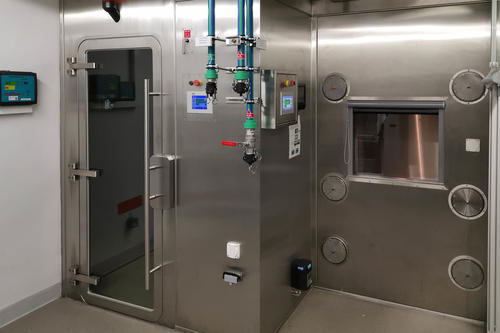Is There Something in the Air?
Scientists at Freie Universität investigate whether and how the novel coronavirus can be transmitted via aerosol particles.
Jun 24, 2020
Researchers at Freie Universität are investigating the risk of infection with SARS-CoV-2 from virus-contaminated air. The virus lasts longer in closed rooms than in the open air.
Image Credit: Picture Alliance, Uwe Rösler
Just 18 days after a church service in a Baptist congregation in Frankfurt am Main, in which people had sung in a closed room without mouth-nose protection, an infection with SARS-CoV-2 could be traced to 200 people in this gathering. Noticeable infection events such as this one in the Hessian capital are indications that corona infections can be caused by aerosol particles.
So far, as with other seasonal corona or flu viruses, the SARS-CoV-2 infection appeared to be mainly caused by droplets: When sneezing or coughing, infected people release larger droplets that can infect another other person nearby. Due to their weight, these droplets fall to the ground relatively quickly – unlike the tiny aerosol particles, which once expelled by breathing, can remain suspended in the air for many minutes or even hours. In this way, the viruses packaged in these small particles could lead to infection even without direct contact with an infected person, for example by entering a room with contaminated “standing” air. But how infectious are aerosols actually?
In the bio-aerosol chamber, scientists can study the infectivity and persistence of various corona viruses in the air.
Image Credit: Picture Alliance/Abdulhamid Hosbas
Freie Universität, Charité, and Technische Universität Are Doing Research Together
Scientists at the Institute for Animal Hygiene and Environmental Health at Freie Universität are working in cooperation with hospital hygienists at Charité –Universitätsmedizin Berlin and researchers at Technische Universität Berlin. Air samples are taken from the immediate vicinity of COVID-19 patients using a so-called air sampler. These are then cultivated, examined and characterized in a so-called S3 laboratory for working with highly pathogenic pathogens in the Robert-von-Ostertag-Haus in Düppel.
“We are trying to isolate infectious SARS-CoV-2 from the air in order to be able to estimate how high the risk from contaminated air actually is,” says Professor Uwe Rösler, Managing Director of the Institute for Animal Hygiene and Environmental Health. “The colleagues from Technische Universität and Charité will then use our data to create models that, among other things, answer the question of how far these particles are transported.” So far, the scientists have succeeded in detecting viral RNA, i.e., genetic SARS-CoV-2 material, in the air environment of COVID-19 patients, but not the still infectious virus.
How Long Do Corona Viruses Survive?
That is not surprising in and of itself because "Coronaviruses are actually very sensitive to drying out," says Rösler. They are transmitted through air, but cannot last long in air, depending on the weather, because they dry out quickly. With SARS-CoV-2, however, there are indications that the environmental stability could be higher. The scientists now want to clarify the concentration of the viruses in the air in the vicinity of COVID-19 patients as well as how long they remain in an infectious state.
They will also compare SARS-CoV-2 with other human and animal corona viruses, using a fully air-conditioned bio-aerosol chamber. “In this test chamber, we can generate virus aerosols and distribute them in the air,” says Uwe Rösler. He said that the investigations into the environmental stability of the corona viruses can take place here under very well defined climatic conditions and are easy to reproduce.
Infectivity of Aerosols
Knowledge about the possible infectivity of the aerosols and their property of spreading in the air is also important for another cooperation project of the veterinarians. Together with scientists from the Robert Koch Institute and other institutions, they are conducting research as part of the EKOS project funded by the German Federal Ministry of Education and Research on the spread of highly infectious, easily transmissible pathogens.
The abbreviation EKOS stands for “Entwicklung eines neuartigen Konzepts zur Sicherstellung der infektiologisch-medizinischen Versorgung von Patienten mit Krankheiten durch hochpathogene Erreger in Schwerpunktkrankenhäusern” [Development of a novel concept to ensure the infectious and medical care of patients with diseases through highly pathogenic pathogens in specialized hospitals]. “We were originally thinking of the spread of highly contagious, very dangerous pathogens such as the Ebola virus, in German hospitals in crisis situations,” said Rösler.
Now the research project was overtaken by reality and expanded to include issues related to SARS-CoV-2: How can safe medical care be guaranteed for COVID-19 patients in hospitals? How can hospital staff be protected? How should a temporary isolation area in emergency rooms and normal wards in hospitals be equipped?
As of June 12, 2020, the Robert Koch Institute rated the risk of transmission from aerosols on its website as follows: “Transmission of SARS-CoV-2 by aerosols is possible over certain distances in certain situations, for example, if many people come together in rooms that are not sufficiently ventilated, the minimum distance is not maintained, and there is an increased production and enrichment of aerosols. The extent to which transmission can occur in such situations has not yet been conclusively investigated.” Infection events such as the outbreak in Hesse suggest this is possible, but so far, there is no scientific evidence available.
This text originally appeared in German on June 21, 2020, in the Tagesspiegel newspaper supplement published by Freie Universität.


